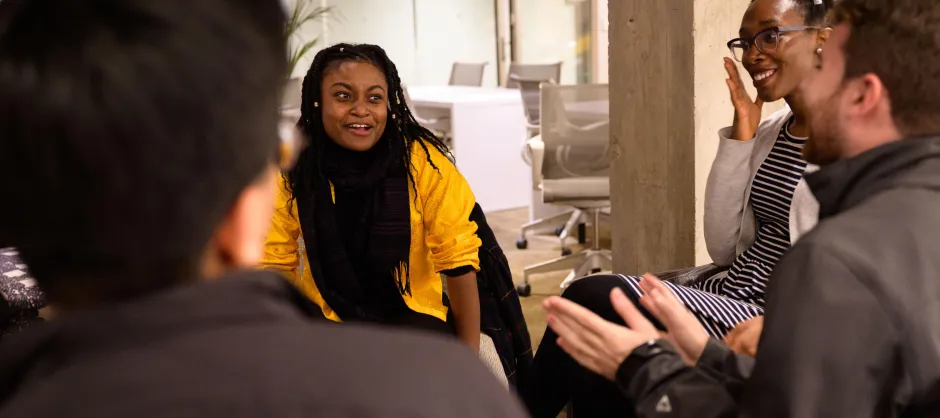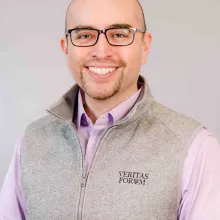
The Art & Science of New Student Outreach
Did you know we have a whole set of resources for New Student Outreach (NSO) ready to go? These include prayer guides, how to do network mapping, leadership team planning guides (for NSO), and more. Check out the collection here.
A Tale of Two NSOs
Greg loves his advisor and his engineering department. After a tough first semester finding his way, he got involved in GFM, started leading a small group and now is committed to helping other new grad students find GFM. Greg loves to serve and so at the first event of the year he was committed to ensuring everyone who came got food and a smile while coming through the line. Unfortunately, he had no conversations with new students.
Casey was part of a big InterVarsity chapter during her undergrad. When she started grad school at her new campus, she got connected right away to GFM. She has been eager to see her chapter meet a ton of new grad students. She availed herself of some university funding and a few volunteers and put together an impressive NSO event that fed hundreds of new students and even was able to give away some great GFM swag. At the end of the event about 60 students expressed interest, but Casey and the two other leaders felt pretty overwhelmed (and already tired!) at the thought of engaging all these names that were in departments across the whole university.
Can you identify with part or all of either of these NSO experiences? I know I can. I also see some big challenges. Let me explain: while both stories highlight the genuine love we have for new students, humility in service and an understandable desire to get GFM’s name out on campus, both also highlight some common NSO pitfalls.
The Role of the Returning Leader Challenge
In this situation, what is happening is that we default to the place we are most comfortable or where the event seems to need support. This makes sense as we have an intrinsic desire to see events succeed. But, there is a tension here: with NSO events success is rarely about how the event was run and more about making personal connections with new people.
Some of the best conversations I’ve had were when an event rained out or right after the event ended so the new student didn’t even get any food! Here’s the key takeaway: we have to make courageous hospitality our number one value. Sure, an event can help set-up connections, but as ministry leaders, our job is to welcome, start a conversation and be active listeners. You can’t do this from behind a serving line.
What would it look like for every returning member to be prayerfully welcoming and engaging new students in order to welcome them into a small group?
The Super-Event Challenge
When we walk around campus it’s hard to not notice the groups that have funding and do marketing well. They have polished posters, great speakers and really good swag. Often without realizing it this philosophy works its way into what we think a successful NSO event is. We might even think that a big event will help our chapter to grow–even double in size. Even if we’re not convinced of this, we can still operate with some shame or envy when our events seem small by comparison.
Here’s the key takeaway: the best NSO events create connections proportional to your group size. I’ve led events that serve thousands of people for NSO but usually events like that by themselves don’t help your chapter grow. Additionally, a public event at a secular campus will almost always produce a 1:5 interest ratio meaning only 20% of those who attend will indicate any interest in your group (it’s a bit like cold-calling in advertising). Unfortunately, even less will actually attend or join. And, unless you have a leadership team committed to a pretty intense follow-up program, you won’t be able to meet most of those folks.
Here’s the good news: if you major in preparing to engage relationally and if you right-size your NSO plans, you can have a great NSO!
Planning for Growth
Did you know that the growth of InterVarsity chapters follows the standard deviations on a bell curve? And, a 50th percentile chapter (the middle of the curve) in our movement doesn’t grow! That means growth doesn’t happen by accident; we have to be purposeful. But, here’s the good news, with some preparation and planning, it’s very reasonable to grow by 4-5 new students–this is around the 65th percentile mark, where the red arrow is in the diagram. Think of this like growing in a way that helps you start one new small group.
Three Steps for Successful NSO Plans
- Prepare - We must prepare spiritually for the fall. It takes courage and persistence to welcome new people. And, it’s a bit mysterious. We are not in control of who we meet. We need to pray so as to meet the folks God has for us. When you do plan, focus on simple hospitality that easily translates into invitations into small groups. Think about an event in a department on mental health or human flourishing featuring a faculty speaker that helps you reach an existing network and a potential new one.
- Engage - As you run your events, remember it’s about the relationships that God is forming, not the success of the event as it might have appeared on paper. Watch for “people of peace” who unlock networks. For example, a social work student who comes to an event in the School of Education might help you realize a new small group is possible in social work.
- Grow - Be open to growing in existing and new ways. In Acts 16:6-15, Paul and his team prepared by praying before the trip to Philippi. They engaged the city by visiting synagogues, markets, and places of prayer. They met Lydia, who was eager to be baptized and to open her home (and network) to them. God unlocked new growth through Lydia. How might God want to grow existing networks and open new ones for you? Grow where God opens the doors!
Additional Tips
- The journey of new students from meeting us at an event to being engaged in follow-up to joining our groups follows a predictable pattern that is shaped like a funnel. Our Ministry Intelligence has done a great job in helping you look at the shape of your funnel for your area or region. Log into the Staff Portal and navigate to the Insights tab to learn more (there’s a helpful video tutorial there, too).
- Your funnel ratio can help you pace yourself. If you average NSO for all GFM chapters, you’ll see that for every new student that joins, three were followed-up on and five were new contacts. This can help you set expectations for your event and for your NSO plans as a whole. For example, if you right-size a hospitality-oriented event and meet 15 new people who have some level of spiritual interest, you can expect that around three of those folks might join.
- Be careful to not get overly pragmatic with the funnel. It helps illustrate the stranger-to-member journey, but thinking about new students through the metaphors of neighborhoods and networks is far more helpful and keeps us watching for how people are connected in community. Remember Lydia!
Did you know we have a whole set of resources for NSO ready to go? These include prayer guides, how to do network mapping, leadership team planning guides (for NSO), and more. Check out the collection here.
GFM NSO/JNSO Ideas
Low-Prep Outreach Ideas
Here are some low-prep outreach ideas to help staff or student leaders meet students on campus:
- Do a network map and ask the Holy Spirit to reveal people God would like you to begin to pray for. Text those people, let them know God put them on your heart, and ask them how you can pray for them.
- Take a prayer walk through campus or specific departments and offer to pray for those you meet as the Holy Spirit leads.
- Invite students to a home for a home-cooked meal.
- Do study hours where everyone meets at a coffee shop or somewhere to study together.
- At mealtimes, invite two classmates or colleagues to eat with you. Get to know them, asking questions that start with “what” and “how.”
- Pick that month’s holiday (or make up your own!) and gather people in your network for a potluck around it. Pick a central location, for example, someone’s home or the school’s cafeteria.
- Invite students to play frisbee, soccer, toss a ball, foosball, etc. with you.
- Invite friends to play your favorite video game with you.
- Jam with students who play instruments.
- Go to the gym or play pick-up games.
- Offer weekly rides to grocery and retail stores to those in your network, especially those without access to cars.
- Give rides to church on Sunday mornings.
- Have a game night (Spoons, Spades, Mafia, etc.) and invite everyone in your network.
- Become a conversation partner with an international student.
- Go to events where students are already gathering. Ask the Holy Spirit to help you to listen to people there, asking “what” and “how” questions as appropriate. Ask God how He would like you to engage.
- Have your students prepared to tell stories, both from the Bible and what your group has seen God do on campus, in their departments, in their industries, and in their own lives.
- See if there are grad orientation events where you can table.
- Adapt a proxe to grad students (such as the self-care proxe), and table in areas of likely grad traffic.
- Go on a hike together.
- Progressive Dessert/Meal.
- Ice Cream Social.
Ideas for a Core Group of Committed Students
Once you have a core group of students that are committed to the group, try these ideas:
- Coach students on how to have a spiritual conversation.
- Use this resource: Walking with Non-Christian Friends through the Five Thresholds
- Start each meeting by sharing what God is doing on campus.
- Restate the vision - share ways the group has seen the vision become reality.
- Actually say the vision each time in addition to sharing praises.
- Have conversation starters ready for impromptu discussion and deeper conversation. For example:
- What’s your spiritual background?
- How were you first introduced to Jesus? How has your relationship with God grown since then?
- What made you choose to get your master's or PhD in ________?
- What do you hope to do with your master’s degree or PhD?
- Cast vision for the fellowship as a team.
- Invite students to dream about what their department/industry could look like if it were a more just and gracious place.
- Invite students to dream about what this fellowship could look like so that the above dream could become a reality.
- Invite students to dream about what their lives could look like so that the fellowship dream could become a reality.
- Help students learn how to invite people well. This includes how to talk about what your fellowship is about and what you are doing on campus.
- Have students text an invitation to people in their network to connect. (You can have everyone pull out their phones while you are together and each person text someone and invite them to the next event).
- Coach students on how to invite well. Use this Inviting Well Quicksheet.
- Debrief the experience after students have connected with someone in their network and made an invitation.
- Teach the practice of listening prayer to students.
- A great resource for how to lead listening prayer: Depending on the Spirit Quick Sheet.
- Use the campus map as a visual if you are not able to get outside to prayer walk (or use their department’s org chart).
- Help students learn to share their testimonies.
- They should be able to tell their stories without “Christianese.”
- They should ask the Holy Spirit for opportunities to share their testimony.
- They should have a non-Christian friend proofread their written testimony.
- Role play can be helpful for this learning process.
- Create a proxe station or spiritual survey and use it on campus or join an undergraduate fellowship in a joint public outreach.
- Send students on a prayer walk and have them pray for and with the people they meet on campus. Afterward, debrief the experience.


